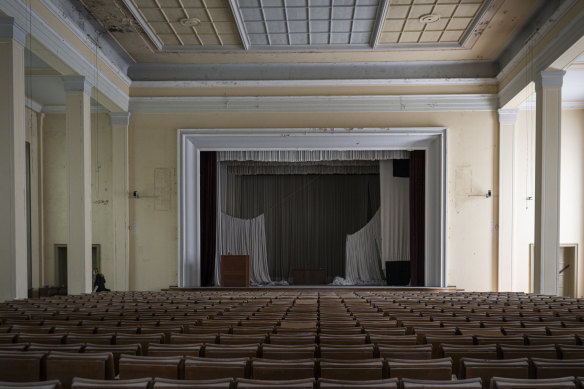“The history of the place is precisely the reason why Berlin would never hand this building over to private hands where there would be a risk that it could be misused,” Evers said.
The villa’s fate is not only a logistical quandary for Germany. It illustrates a long-term and larger conundrum, the grounds of which have shifted over time, experts say: whether to preserve or obliterate the many edifices from Germany’s hateful past.
Marita and Frank Bernhardt visit the former culture house built by the Communist Party.Credit: Lena Mucha/The New York Times
Directly after World War II, the prevailing approach was to move on, ignoring prior ownership, so as not to risk reifying it, according to Peter Longerich, a historian and the author of Goebbels, A Biography. Hitler’s apartment in Munich, for example, has little information detailing its history; it has long been a police station in which officers still use Hitler’s own wooden bookshelves, he said.
The benefit of its law enforcement tenants is that their presence keeps at bay Nazi sympathisers who sometimes make pilgrimages to such sites. Last year in Austria, the government moved to convert Hitler’s birthplace into a police station for this reason, drawing contentious debate.
But as the far-right has re-emerged in German politics, sentiment has shifted towards remembering the past in order to never forget it.
Loading
“The dominant attitude in education for a long time was to, if possible, ignore many things of this period,” Longerich said. “But nobody has a greater sense of coming to terms with the past than Germans have, so there is an ongoing process,” he added. “And it might be that over time, ignorance will need to be overcome, and people find it necessary to preserve this space.”
Just outside the centre of Wandlitz, the wildwood has grown up around the house, blocking the door to the private cinema where Goebbels screened his propaganda films. Cobwebs cloak bedroom windows. And motes of dust drift through airy salons where he wined and dined Nazi leadership and where his six children played beside the hearth – until he and his wife poisoned them all in the war’s final days.
Maintenance of the property costs €280,000 a year ($465,000) just to keep it from falling into shambles, according to the buildings department. Restoration would not only be expensive but introduce another thorny issue that dogs preservationists who must deal with former structures from both the Nazi and communist chapters of Germany’s past.
“If they look too beautiful, you re-aestheticise their reign,” said Thomas Weber, a professor of history and international affairs at the University of Aberdeen, in Scotland. “But if you leave them but somehow destroy how they functioned at the time, then people will not understand, either.”

The lecture hall used by the Communist Party.Credit: Lena Mucha/The New York Times
The mansion is filled with architectural flourishes that were popular among Nazi leaders, like its clever day-room windows that fold away into the floor – a touch also used in Hitler’s own holiday retreat in the Bavarian Alps. There is a bunker out the back, too, just in case.
Other structures were added over time. Down a path, past headless concrete statues of intertwined lovers, are several almost federal-style buildings. They were used as a communist international youth college from the 1940s until the fall of the Berlin Wall. Up weed-sprouted steps and behind graffitied doors, their cavernous interiors hold barracks and an echoing auditorium.
It is a part of the site’s past often eclipsed by its Nazi heritage, said Gerwin Strobl, a modern history instructor at Cardiff University in Wales, who studies Germany. But it is one also painful to Germans. “In fact, it covers two German dictatorships in succession. That also explains why it is also so difficult to find a use for it,” Strobl said. “But buildings by themselves aren’t evil.”
Loading
On a bike ride on a recent Friday, a man and a woman in their 60s paused in front of what was the campus’ social centre to take in the crumbling building. The pair, Marita and Frank Bernhardt, had met there as students in 1978.
She learned of its Nazi past only after reunification, Marita Bernhardt said. “That’s why it has a bitter aftertaste,” she said of returning for the first time. And yet, it was where she and her husband had fallen in love. “The memories are still nice.”
After hearing about Berlin’s offer to give away the property, Rabbi Menachem Margolin, chair of the European Jewish Association, sent an open letter offering to convert it into an education centre to counter all forms of hate.
“It is an important message to anyone,” Margolin said. “That even the darkest place in the world can become a source of light.”
Such a project is worthy, Evers said, but the issue is financing. Walter Reich, former director of the United States Holocaust Memorial Museum, said it was Germany’s obligation to help pay. “That’s part of the burden of German history,” Reich said in an email. “Germany’s unmasterable past.”
As the ash and alder creep over the villa, Oliver Borchert, the mayor of Wandlitz, has for years fended off interest from extreme right-wingers, including the coup-plotting Reichsburger group.
The place needs more than upkeep – it needs transformation, Borchert said. “You have to find a use that can stand against and reflect the shadows of the house and its history.”
This article originally appeared in The New York Times.





















Discussion about this post